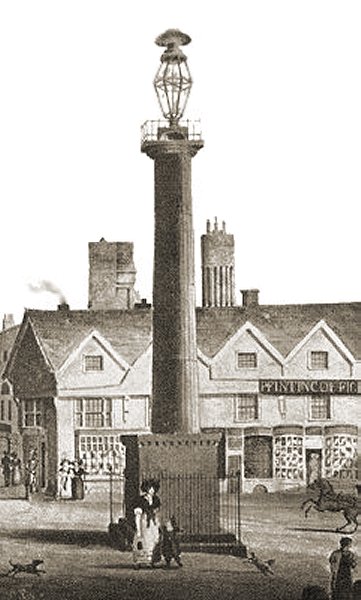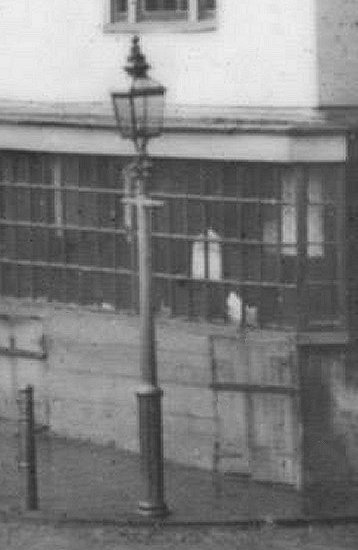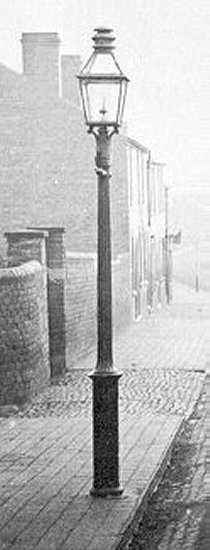|
Wolverhampton changed dramatically
as a result of the building of the local canals. In
August 1771 the canal from Birmingham, built by the
Birmingham Canal Company reached Wolverhampton. On 21st
September, 1772 the Staffordshire & Worcestershire Canal
opened, and four months later the difficult 1½ mile
section from Wolverhampton to Aldersley Junction was
completed.
The new form of transport overcame
most of the problems caused by the inadequate national
road system of the day, and vast amounts of goods of all
kinds were transported to the town. But Wolverhampton
still had its medieval street plan with narrow winding
streets that formed a bottleneck for the many carts and
carriages transporting items into the town, from the
canal.
For many years the town had been in
the charge of the Constables, public executives
appointed by the Manors of the Deanery and of Stowheath,
who had a limited range of duties. Many local
inhabitants were no longer content with their rule, they
wanted changes to be made in the town centre, including
the demolition of old crumbling buildings, a better
water supply, and improvements to the roads.
The
1777 Improvement Act
This led to the first Act of
Parliament relating to the town, the 1777 Improvement
Act for Wolverhampton which appointed 125 Commissioners
to run the town. It started in a small way on Friday
30th May, 1777 when twelve men met at the Red Lion Inn
in North Street to take the first tentative steps
towards local government.
The introduction to the Act
includes the following: “It is a large, populous trading
town and it would be a great convenience to the
inhabitants if the streets were widened where necessary,
and properly cleaned and lighted, and because a
navigable canal has lately been made up in the said
town, the number of carts and carriages used in carrying
and conveying goods and merchandise is greatly increased
and it is essential that they be put under proper
regulations.”
The Act named 125 Commissioners,
all local residents, who were joined by Stewards of the
Manors of the Deanery and of Stowheath, and Prebends of
the Collegiate Church. To qualify for office,
individuals had to own property worth more than £12 per
year and land or goods worth more than £1,000. It was
thought that those with the most expensive property were
the fittest to rule. The Commissioners represented no
one except themselves, they looked after their own
interests.
In June, 1777, they appointed James
Horton as clerk, and agreed to pay him one guinea for
each of their meetings, in return for writing-up the
minutes and ensuring that their orders were properly
carried out. Littleton Powis was appointed as rate
collector, John Marshall as treasurer, and Joseph
Barney, Joshua Devey, and John Smith as assessors.
The meetings were held at various
pubs, including the Hop Pole, the Bird in Hand, and the
Swan, all in the Market Square; the Cock Inn in Berry
Street; the Talbot in King Street; the Angel in Dudley
Street; and the Red Lion in North Street. It was decided
that each Commissioner shall pay not less than sixpence
at each meeting, to be spent in drink for the good of
the house! |

High Green from Isaac Taylor's map
produced in 1750. The market hall is coloured green, and
'roundabout house' is orange. |
| Demolitions and
Street Improvements The
Commissioners were empowered to remove nuisances and
encroachments. One of their first tasks was to demolish
the old Market Hall in High Green which had fallen into
a bad state of repair. It had been built in 1532 and
measured 68ft. by 29ft. 4 inches, and was later known as
“The Old Town Hall”. The upper floor had been used for
the Assizes, and on the ground floor were butchers'
shops and a slaughter house. In the area alongside the
building, known as the shambles, skins of slaughtered
animals were left on the ground in a filthy and
disgraceful condition. The building was demolished in
1778, and the butchers’ shops and the shambles were
moved, after some opposition from the traders, to Pigstye Walk, alongside St. Peter’s churchyard. After
the work had been carried out, the market place was much
cleaner and healthier.
People were forbidden to ‘wash any
brass dirt or ashes, or any kind of metal’ in the
streets, for which there was a fine of ten shillings,
and stall owners in the market place and the surrounding
streets were to ordered to remove their stalls before
twelve o'clock at night on Wednesdays and Saturdays, and
before ten o’clock on other nights. Scavengers were
ordered to go round once a week and inform the
inhabitants of their approach, using a loud bell or
shouting. Their job was to collect ashes and rubbish
from places that were inaccessible to carts, such as
yards at the back of houses. A fine of five pounds was
introduced for anyone involved in bull or bear baiting,
and a fine of twenty shillings was to be paid by anyone
who slaughtered any animal in the streets. Properties
with an annual value of four pounds, and not exceeding
seven pounds were rated at 4 pence in the pound, and
properties with an annual value of seven pounds, and not
exceeding fourteen pounds and six pence were rated at
one shilling in the pound.
The Commissioners then turned their
attention to the dark, crooked, narrow, and dangerous
streets. Oil lamps were hung on street corners, and
every ale house was ordered to fix a lamp over the door.
Although the illumination from such lamps was at best
dismal, it was the only option. Gas supplies did not
exist at the time.
Some of the people who lived in the
more narrow streets, received an order to demolish the
porch on the front of their house because it was seen as
an obstruction. The Commissioners ensured that all the
streets were named, using white letters six inches high
on a black background. At the same time all the houses
and buildings were numbered. They also decided that
something had to be done to improve the town’s water
supply. The waterworks were totally inadequate, and so
the lack of supply was partly remedied by the sinking of
wells around the town centre, at places including Town
Well Fold; High Green, Salop Street, Snow Hill, North
Street, Bilston Street, Walsall Street, Stafford Street,
and the Culwell near Cannock Road. |
|

The western side of the town
before the building of Darlington Street. From Isaac
Taylor's map. |
| More Improvements
The problem of the inadequate water supply was discussed
during a Commissioners’ meeting at the Cock Inn in
August 1779. At the meeting the treasurer was instructed
to pay Mr. Bowick £1.4s.8d. for taking the levels of
springs at Goldthorn Hill; and Mr. Junett was paid £29
for supplying a water cistern, 18 feet wide and 35 feet
long, which stood in the market place, and also for
repairing some of the other waterworks in the town.
Unfortunately the water supply was still inadequate, and
so some residents sunk wells in their back garden to get
a better supply than could be obtained from the public
wells. Also in 1779 Samuel Salt was appointed as parish
beadle.
The Commissioners also considered
the possibility of providing suitable stalls on market
days, in the market place. It was agreed that Mr. Higgs
could erect stalls at his own expense and charge one
penny for each separate basket brought into the market.
Later they agreed that he could rent the ground
previously occupied by the market hall, and the now
demolished water cistern, for seven pounds ten shillings
annually for ten years.
In 1793 the Commissioners decided
to divide the town into ten districts, and employ extra
scavengers to clean the streets. They also entered into
a contract for lighting the town’s streets, and improved
policing by appointing a watchman for each district to
control crime, particularly because there were frequent
robberies with violence, especially at night. Each
watchman had a watch box to shelter in, and was dressed
in a heavy fawn coloured coat, with a cape, and provided
with a dim horn lantern, a large wooden rattle, and a
long stave. Every half hour they would leave their watch
boxes for a few minutes to call the time, and the state
of the weather.
The Town Improvement Act of 1814
banned the use of thatched roofing, although the last
thatched building in the town, a cottage in Broad
Street, remained until the 1870s. In order to improve
the state of the streets, the Commissioners ordered that
every person should clean the area in front of his or
her house before 10 o'clock on every Thursday and
Saturday morning, and that some of the poor men from the
workhouse should sweep and clean the streets.
Darlington Street
Another old building, seen as a roadside obstruction
was the ancient ‘roundabout house’ that stood at the
western end of High Green between North Street and Cock
Street (now Victoria Street). It was in a dilapidated
and dangerous state, and in May 1815 was sold to the
Commissioners by Sam Adey, the owner, for £800. The
building was soon demolished. The materials from the
building were sold by auction to the highest bidder.
When the building had gone, the Commissioners decided to
build a new street from the western end of High Green to
the bottom of Salop Street. They approached the land
owner Lord Darlington and agreed to purchase the land
for £350 per acre. The new street became Darlington
Street. |
|

The newly built Darlington Street.
From the 1842 Tithe map. |
|

The big candlestick in High Green. |
As already mentioned, the streets were originally
lit with totally inadequate oil lamps. This situation
was rectified in 1821 when for the first time the
streets were lit by gas.
The town’s gas supply was provided by the
Wolverhampton Gas Company, and produced at the gas works
that were built in Horseley Fields, and began production
on 17th September, 1821.
The gas lights were a great success, and a large cast
iron column about fifty feet high, carrying a huge gas
lamp, was erected in High Green to commemorate the
event. Because the column was so high, the light did not
reach the ground, and it became known as ‘the big
candlestick.’
By 1826 the pillar of the lantern and the railing
round its base became dirty, and the surrounding area
was a rendezvous for the local layabouts and
degenerates.
It became a public nuisance and was eventually
removed in 1840. In 1824 the gas company renewed the
contract for lighting the streets at a cost of £1.16s.
per lamp per year. |
|

A gas lamp in High Green. |
|

A typical gas light. |
|
Waterworks
The Commissioners supported a Bill
for the formation of the Wolverhampton Waterworks
Company to supply the town with water. The waterworks
company was formed in 1845 and a new waterworks was
built in Regis Road, Tettenhall. Up to 800,000 gallons a
day were pumped from boreholes and stored in reservoirs.
The Commissioners also gave their support to a Bill to
provide a new cemetery, which led to the building and
the opening of Merridale Cemetery in 1850.
Dissatisfaction and Change
By the 1840s there was a great deal
of dissatisfaction with the Commissioners. The question
of a network of sewers for the town attracted much
attention, but the Commissioners’ borrowing was limited
to £20,000 so nothing was done. People were also
dissatisfied because the Commissioners were not elected
by the ratepayers and could choose anyone they wanted,
to fill their vacancies. They also appeared to work
extremely slowly. Other dissatisfactions included the
incompetent watchmen, beadles, and parish constables,
who were all open to bribery.
Dissatisfaction grew, and on 1st
February, 1847 a petition was signed by 108 of the
principal householders, and presented to Mr. John
Hartley, the Head Constable, asking him to call a public
meeting to consider the possibility of petitioning
Parliament and the Queen to ask for the granting a
Charter of Incorporation for the town. As a result of
the successful application, the Commissioners were
replaced by a Borough Council in 1848. The first council
elections were held on 12th May, 1848.
One of the Commissioners’ last acts
was the purchase of a large piece of land beside
Cleveland Road from the agent of the Duke of Cleveland,
for the construction of a cattle market for the sale of
horses, cows, sheep, and pigs.
References:
The Book of Wolverhampton by Frank
Mason. Pub. Barracuda Books Limited, 1979.
Wolverhampton The Town Commissioners by Frank Mason.
Pub. Wolverhampton Public Libraries, 1976.
The Story of the Municipal Life of Wolverhampton by W.
H. Jones. 1903. |
 |
|
Return to the
previous page |
|